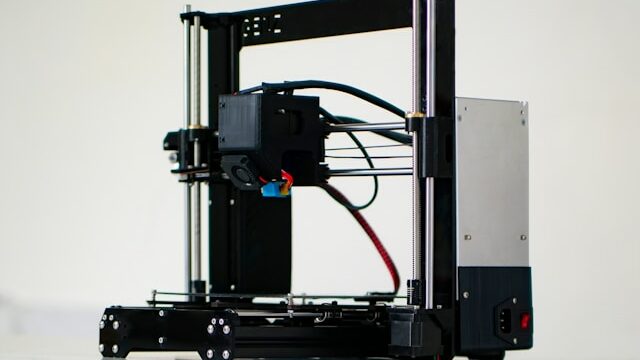Do you have questions about wood 3D printing and its specificities? Imprimy is here to explain everything about 3D printing with wood composite filaments.
Wood 3D printing uses a composite filament mixing polymer and wood powder to create objects with a natural and textured finish close to real wood.

What is wood 3D printing?
wood 3D printing allows for the production of three-dimensional objects using a blend of plastic and wood particles. The texture of the resulting objects closely resembles that of real wood.
Definition of wood 3D printing
Wood 3D printing refers to an additive manufacturing technique using a composite filament mixing plastic material and wood powder. This technology allows the creation of objects by layering successive layers, with a texture and visual appearance close to natural wood.
It combines the ease of 3D printing with the warm and eco-friendly aesthetic of wood. This process offers a durable and creative alternative to traditional materials. Thus, it opens new possibilities for design, craftsmanship, and custom manufacturing.
Composition of wood 3D printing Materials
Materials for wood 3D printing are mainly composed of a mixture of polymer (usually PLA) and natural wood powder. This powder can come from different types such as oak, pine, or bamboo, providing varied textures and colors.
The proportion of wood in the filament influences the strength, flexibility, and final appearance of the printed object. This composite material allows for an aesthetic finish close to real wood while being easy to print. It is also valued for its reduced environmental impact compared to pure plastics.
Appearance and Texture of 3D Wood Prints
Wood 3D prints offer a warm and natural appearance, with color shades reminiscent of real wood. The texture is slightly rough, mimicking the wood grain, which gives an authentic feel. Depending on the type of wood powder used, finishes can be smoother or more rustic.
After printing, the objects can be sanded, stained, or varnished to enhance their realism. This unique finish makes wood 3D prints an ideal choice for aesthetic and tactile creations.
Techniques of wood 3D printing
The creation of 3D wood prints involves choosing the right 3D printer and integrating specific parameters to facilitate the post-processing of the objects once they are printed.
Choosing 3D Printers for Wood Printing
To print wood in 3D, it is preferable to use FDM 3D printers compatible with composite filaments. These machines must be able to handle reinforced nozzles to avoid wear caused by the abrasive wood powder. Good extrusion precision is essential to preserve the wood grain details.
Printers with a heated bed facilitate filament adhesion during printing. Finally, fine temperature adjustment allows for better quality and an optimal texture.
Specific Parameters for wood 3D printing
To succeed in wood 3D printing, the extrusion temperature should be adjusted between 190°C and 220°C depending on the filament. The printing speed must be moderate, often around 40-60 mm/s, to avoid clogs.
Cooling settings are important: a partial fan helps maintain the texture without weakening the object. The recommended nozzle diameter is generally 0.4 mm or larger to prevent wear. Finally, it is advised to calibrate bed adhesion with a smooth surface or specific glue to avoid warping.
Post-Processing of 3D Wood Prints
The post-processing of wood 3D prints improves their aesthetics and durability. It often starts with sanding to smooth the surface and reveal the natural wood grain.
Next, oils, varnishes, or stains can be applied to protect and enhance the color. Gluing or drilling remain easy thanks to the wood-plastic composition.
Finally, these finishes strengthen the authentic and tactile appearance of the printed object.
What are the advantages of wood 3D printing?
wood 3D printing allows for the creation of pieces that closely resemble real wooden objects, but with greater customization and versatility than raw wood.
The aesthetic aspect of 3D wood prints
The aesthetic aspect of wood 3D prints is distinguished by a natural texture that perfectly mimics the grain of real wood. The objects display warm tones and color variations specific to each type of wood used.
This aesthetic brings an organic and authentic dimension to creations, difficult to achieve with pure plastic. The finish can be enhanced through post-processing like sanding or finishing with oils. Thus, wood 3D prints combine technology and craftsmanship for a visually unique result.
The customization of 3D wood prints
The customization of wood 3D prints allows the creation of unique objects tailored to each need. The shape, size, and design details can be easily modified thanks to 3D software. The choice of wood type in the filament also offers different natural textures and colors.
Post-processing, such as painting or engraving, adds an extra touch of personalization. This flexibility makes wood 3D prints an excellent choice for custom, decorative, or functional creations.
The ecological aspect of 3D wood prints
Wood 3D prints have an ecological advantage thanks to the use of composite filaments containing a high proportion of renewable organic material, such as wood powder. This material reduces the amount of plastic used, thereby limiting the environmental impact.
Moreover, the wood often comes from sustainable sources or recycled wood waste. The 3D printing itself minimizes waste through additive manufacturing, unlike subtractive processes. Thus, this technology combines innovation and environmental respect.
The versatility of 3D wood prints
Wood 3D prints are extremely versatile, suited for many fields such as decoration, prototyping, and craftsmanship. They allow the creation of objects that are both aesthetic and functional, combining lightness and strength.
Thanks to the variety of wood filaments available, different textures and finishes can be achieved according to needs. This technology adapts well to both small batches and custom unique pieces. Finally, it opens the door to innovative creations blending modern design and natural materials.
What are the practical applications of wood 3D printing?
3D wood prints can be used for interior decoration, to create functional objects, or even to produce artistic pieces.
Wood 3D printing for interior decoration
Wood 3D printing is ideal for interior decoration thanks to its natural and warm finish. It allows the creation of custom decorative objects, such as lamps, frames, or unique accessories. The wood texture brings an authentic and organic ambiance that fits perfectly into various styles, from rustic to modern.
Moreover, post-processing offers the possibility to customize the finish according to preferences, with varied stains or varnishes. This technology combines creativity, personalization, and environmental respect to enhance living spaces.
Functional prototypes printed in wood
Functional prototypes in wood 3D printing combine the aesthetics of wood with the practicality of plastic. They allow testing of shapes and mechanisms while offering a natural appearance.
The moderate strength of the material is ideal for parts not subjected to heavy stress. This type of prototype facilitates quick design validation before production. Thus, it combines creativity, functionality, and realism in product development.
Functional objects printed in wood
Utility objects printed in wood combine natural aesthetics and practical functionality. Examples include pen holders, cases, or lightweight and durable utensils. Their wood texture adds a warm touch, while remaining easy to clean and durable.
Thanks to 3D printing, these objects can be customized to meet specific needs. This makes wood 3D prints an ideal solution for combining design and everyday use.
3D wood prints in art and craftsmanship
Wood 3D prints are revolutionizing art and craftsmanship by offering a new freedom of creation. They allow the creation of sculptures, jewelry, or decorative objects with complex shapes and precise details, difficult to achieve with traditional wood.
The natural wood texture adds an authentic and warm dimension to the works. Artists can easily experiment with designs and finishes thanks to post-processing. Thus, this technology merges technological innovation and artisanal expertise for unique creations.
What is the future of wood 3D printing?
The future of wood 3D printing will involve the development of more efficient materials, the introduction of new 3D printing technologies, and improved accessibility for users.
The improvement of wood printing materials
The improvement of wood 3D printing materials involves optimizing the mix between plastic and wood powder for a better balance between strength and aesthetics. Manufacturers are developing filaments with finer fibers for a more realistic texture and less abrasion on nozzles.
Work is also underway on additives to increase the durability and flexibility of printed parts. The integration of recycled wood or more sustainable sources aims to enhance the ecological aspect. These innovations expand the applications and improve the final quality of printed wood objects.
Advanced wood printing technologies
Advanced wood 3D printing technologies incorporate processes like multi-material printing, combining wood and other filaments for unique effects. The use of specialized nozzles and precise control systems improves the fineness of details and surface quality.
Some printers use laser fusion for stronger and more detailed structures. The development of biodegradable and enhanced wood filaments also improves durability and ecology. These innovations push the limits of design and open new creative possibilities.
The ecology and sustainability of 3D wood prints
Wood 3D printing is recognized for its ecology thanks to the use of filaments made mostly of natural materials like wood powder. This process reduces dependence on traditional plastics, thereby limiting the carbon footprint.
Additive manufacturing generates less waste compared to traditional methods, reinforcing the sustainability of the process. By choosing wood from responsible or recycled sources, a more virtuous cycle is promoted. Thus, this technology combines innovation and environmental respect for a more sustainable future.
The increased accessibility of 3D wood prints
The accessibility of wood 3D printing has greatly improved thanks to the lower costs of wood filaments and compatible 3D printers. Consumer models now offer easy compatibility with these composite materials.
Moreover, 3D modeling software is becoming increasingly intuitive, making custom creation easier. This democratization allows hobbyists, craftsmen, and designers to explore this natural material without heavy investments. Thus, wood 3D printing becomes a technology accessible to a wide audience, fostering creative innovation.
Conclusion: wood 3D printing
Wood 3D prints represent an innovative fusion between modern technology and natural aesthetics. They offer great versatility for creating decorative, utility, or artistic objects with an authentic finish.
Thanks to increasingly high-performance composite materials, this technique combines ecology, customization, and ease of access. Post-processing further enriches the aesthetic and functional possibilities.
Picture by pikisuperstar by Freepik.
The articles published on Imprimy.com are for informational purposes only. They are intended to provide general advice and information related to 3D printing. Imprimy.com cannot be held responsible for the results obtained or the consequences arising from the application of the shared information. We recommend always checking the specific instructions for your hardware and materials before use.


